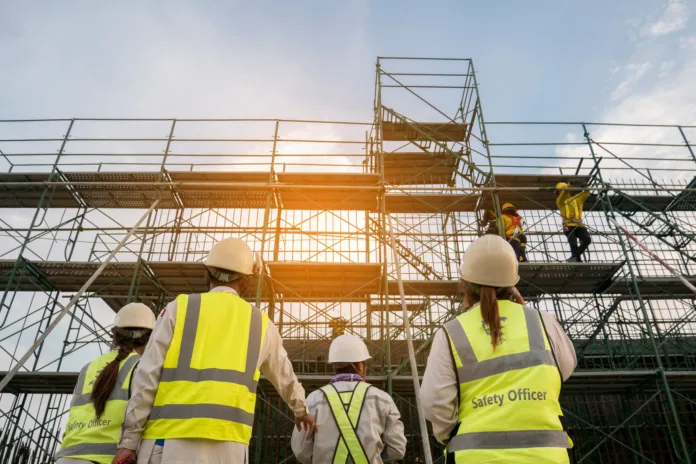Have you ever considered how crucial scaffolding safety is in construction? This fundamental aspect of building work ensures that workers can perform tasks at height safely and effectively.
Yet, despite its pivotal role, scaffolding can present significant risks if not appropriately managed. This underscores the importance of understanding and implementing best practices and necessary precautions.
To assist you in navigating this critical subject, this article will guide you through the key components of maintaining a safe scaffolding environment. It’ll delve into practices that enhance both the safety of workers and the effectiveness of the scaffolding in use.
But first, here are the different types of scaffolding that might feature in your construction project.
Different Types Of Scaffolding
Understanding the type of scaffolding you’re working with is a key part of ensuring safety on the job. Here are a few common types:
- Supported scaffolds – These are structures built from the ground up, with platforms supported by rigid load-bearing members, like poles, legs, or frames. A prime example is the ‘frame’ or ‘trestle’ scaffold used in home construction.
- Suspended scaffolds – Suspended scaffolds are platforms suspended from an overhead structure by ropes or other non-rigid means. An example is the ‘swing stage’ scaffold for high-rise window cleaning.
- Mobile scaffolds – These are a type of supported scaffold set on wheels or casters, which allow for easy movement across the construction site.
- Aerial lifts – These are vehicle-mounted devices like cherry pickers or boom lifts.
The choice of scaffolding depends on the scope and needs of your construction project. Whichever type you choose, prioritizing safety is paramount.

Best Practices When Using Types Of Scaffolds
Adherence to safety standards in scaffolding use begins with these practices:
- Regular Inspections
Inspect scaffolding before use, periodically during use, and after use to ensure structural integrity.
For instance, if you’re using a tube and coupler scaffold, check that all tubes and couplings are firmly connected. Also, take note of any signs of rusting, wear, or defects that might compromise stability.
- Proper Training
All workers should receive adequate training on scaffold use. This training should include climbing safely, carrying tools and materials, and responding to emergencies.
Take mobile scaffolding, for example. Workers must learn to move the structure safely without compromising the scaffold’s stability.
- Weight Restrictions
Always respect the load capacity of the scaffold, as overloading can lead to catastrophic accidents. For example, if using a suspended scaffold, know the weight limit.
This can help you avoid overloading it with too many workers or too much equipment, as it can strain the supporting ropes.
- Securing Tools And Materials
Use tool lanyards or other securing methods to prevent items from falling, as they can pose a risk to those below.
Say, for example, you’re working with a bricklayer’s scaffolding. In this case, securing tools and loose bricks is critical to prevent them from falling onto the work site below.
- Use Of Personal Protective Equipment (PPE)
Hard hats, non-slip boots, and harnesses are vital to ensure personal safety while working on scaffolding.
For example, when working on a rolling scaffold, using a safety harness can provide an added layer of protection. It can prevent falls in case of accidental slips or if the scaffold moves unexpectedly.
Essential Precautions When Using Scaffolding
To further enhance safety while using scaffolding, you should:
- Limit scaffold use to trained workers only. Unauthorized access by untrained individuals can lead to accidents. To avoid this, ensure the site is secure when not in use, and consider implementing visible signage to deter unauthorized access.
- Avoid using scaffolding in adverse weather conditions like strong winds or snow, as they can make the structure slippery and unstable.
- Always ensure there’s a safe and easy way to get on and off the scaffold. For instance, when using a hanging scaffold, ensure there’s a stable and secured ladder or similar access point in place for safe mounting and dismounting.
- Keep scaffolds free from tools, materials, and debris when not in use to prevent tripping hazards.
- Install guardrails on all open sides and ends of the scaffold. Also, use fall protection systems, such as harnesses, where necessary.
By consistently following these precautions, you can significantly reduce the risk of accidents. This way, you can create a safer work environment for everyone involved.
Conclusion
Scaffolding safety is so much more than ticking off a compliance checklist. Instead, it centers on the tangible well-being of construction workers, who put their trust in these structures every day.
By incorporating best practices and essential precautions into your daily operations, you’re doing more than just mitigating accident risks. You’re also enhancing your team’s productivity. Knowing they’re in a safe and secure environment, your team can confidently perform at peak potential.

